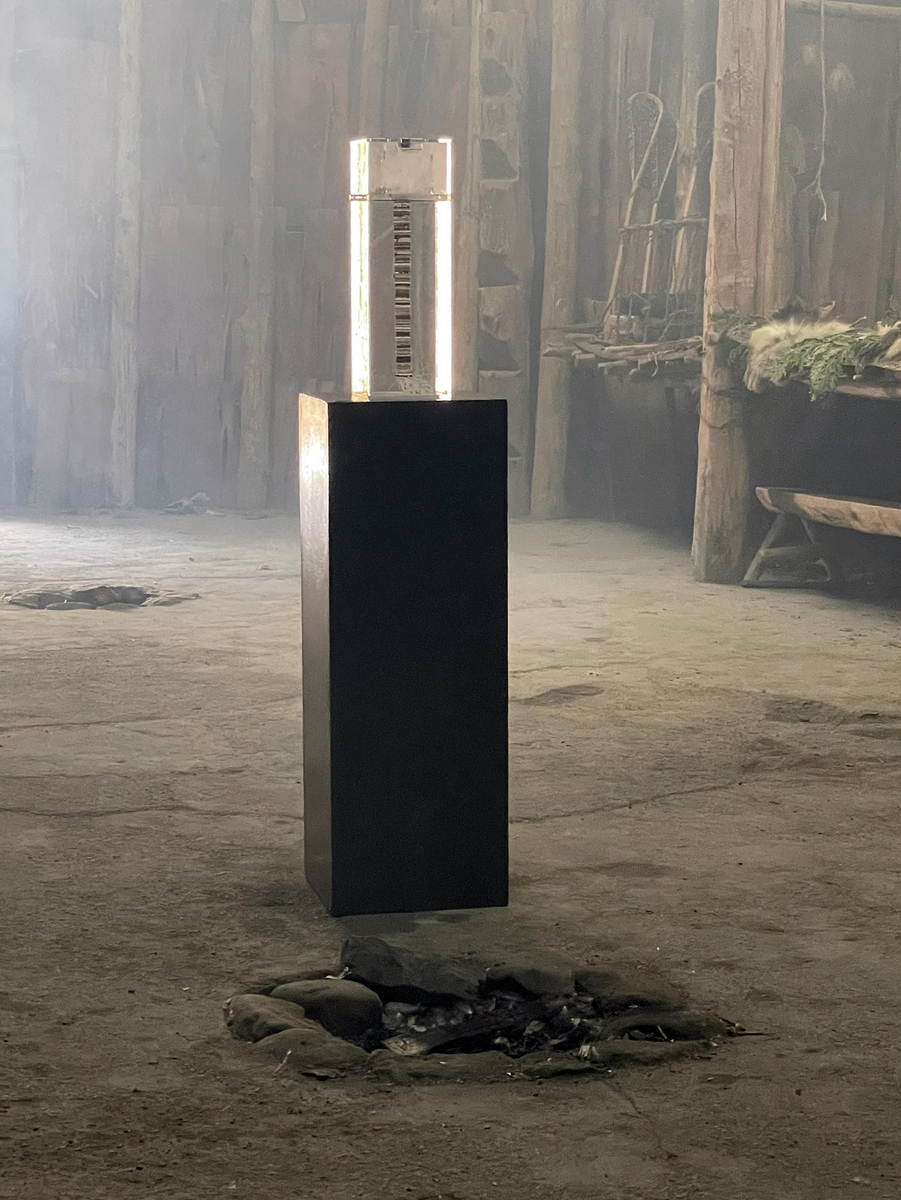Listen, Read, Watch
Podcast (the-green-blues-show): Play in new window | Download
Subscribe: RSS
GPM # 19
Planet Earth. We humans tend to think of it as ours, to do with as we please.
Over the past two centuries, that’s exactly what humans have done. Humanity’s transformation of Earth’s atmosphere, land surface and oceans has a name – the Anthropocene. Dutch chemist Paul Crützen and American biologist Eugene Stoermer coined the term a quarter century ago.
Last week, at a geology conference in Lille, France, a scientific panel presented their formal definition of the Anthropocene — when it began, how it should be ranked in the official geological time scale and where human impacts are best observed in the rock record.
The panel’s proposed location — a little lake in southern Ontario.
To be more precise, the Anthropocene Working Group’s proposed ‘reference standard’ or prototype for the base of a new Earth stage/age and epoch/series is a 2-centimeter segment of a sedimentary core pulled from the bottom of Crawford Lake, in Milton, Ontario, an hour’s drive west of Toronto.
Crawford Lake sediments, as it happens, have been studied for years. Back in the 1970’s, palynologists pinpointed corn pollen there, dating to the 14th and 15th centuries, the legacy of indigenous people who lived along the lake’s shores, cultivating their Three Sisters — corn, beans and squash.
Above those corn pollen grains, in layers (varves) laid down in the mid-20th century, Anthropocene researchers have pinpointed the fingerprints of less benign human activity — spheroidal carbonaceous particles from high-temperature coal burning and radioactive plutonium from thermonuclear weapons tests that peaked in the mid-1950s.
That distinct layer is now being put forward as the Global Stratotype Section and Point (GSSP), marking the base of the Crawfordian stage/age, and a brand new Epoch/series – the Anthropocene — thereby terminating the one we’ve been in for the past 12,000 years, the Holocene.
The more popular name for a GSSP – a ‘Golden Spike’.
This past Tuesday, at the 4th International Congress of the International Commission on Stratigraphy, in the northern French city of Lille, two members of the Anthropocene Working Group (AWG) presented their results.
The geological definition the AWG is now proposing – centering on the Crawford Lake GSSP — will need to be ratified by the body that commissioned it, the Subcommission on Quaternary Stratigraphy. If that happens, the proposal will move up to the International Commission on Stratigraphy (ICS), then to the supreme arbiter of all matters geological, the International Union of Geological Sciences.
At each stage, supermajority approval will be required. The proposal’s future is anything but certain.
If it manages to climb to the pinnacle of the geo-bureaucratic hierarchy, ratification or rejection could be announced in August 2024, at the 37th congress of the International Union of Geological Sciences, in Busan, South Korea.
If the IUGS ratifies the Anthropocene as a new Epoch, terminating the Holocene, it will be a momentous event. Never before have geologists announced the start of a new Epoch in their own life times – one caused by humans themselves.
Crawford Lake’s selection as the proposed Anthropocene’s ‘Golden Spike’ culminates years of analysis. Twelve candidate GSSPs were originally put forward, from locations around the planet. This was narrowed down to nine, of which four received votes in various voting rounds.
Full details on the nine sites can be found here. A great read.
Listen to the AWG’s Anthropocene announcement in this podcast edition. Click on the button on top, or go here.
Colin Waters, chair of the AWG, is the first you’ll hear. Francine McCarthy follows. McCarthy is a geologist at Brock University, and the scientific director of Team Crawford.
This is technical stuff. Listen closely.

Colin Waters, Francine McCarthy and Martin Head outside the STRATI 2023 conference in Lille (David Kattenburg)
Last week’s announcement of a proposed definition of the Anthropocene may come as a surprise to some.
Aren’t we already in the Anthropocene, ordinary people ask?
Not according to those who govern Earth’s official time scale — the International Chronostratigraphic Time Chart.

Judging from the public comments of ranking geologists, the AWG’s proposed formal definition, announced last week in the French city of Lille, may well wither on the geo-bureaucratic vine.
Further indication of which way the wind blows was on display at the International Commission of Stratigraphy’s conference in Lille, last week. After having suggested that the AWG’s proposed definition of the Anthropocene and its candidate Golden Spike could be publicly announced at the conference, organizers did a volte-face.
Crawford Lake findings could be presented to stratigraphers by AWG chair Colin Waters and Crawford Lake researcher Francine McCarthy, they said — as planned — but media would not be welcome. Certainly not film crews.
So, a French camera crew spoke with Waters, McCarthy and Brock University geologist Martin Head outside the conference hall (see photo above).
That evening, their public announcement took place at a Lille hotel, in partnership with the Berlin-based Haus der Kulturen der Welt and Max Planck Institute for the History of Science, who helped fund the AWG’s work.
If the AWG’s Anthropocene proposal does end up getting deep-sixed by higher geological authorities, a large pack of hardworking geologists will be crestfallen.
The AWG’s 38 members (23 voting; 15 advisory) have been labouring on their proposal since 2009 — increasingly so over the past four years.
Then there are the geologists, geochemists, palynologists and other specialists associated with the dozen candidate sites originally in the running for the Anthropocene’s Golden Spike. Hundreds of them.
Among these, no one has worked harder than the scientific director of the winning candidate, Crawford Lake — Francine McCarthy.
I spoke with McCarthy the morning after the July 11 Big Announcement in Lille.
Listen to our conversation in today’s podcast. Click on the button on top, or go here.

Francine McCarthy (second from left), Carleton University colleague Tim Patterson, to her left, other members of Team Crawford, Halton Conservation Authority staff and a friend, on the lake’s boardwalk. (David Kattenburg)
Francine McCarthy pays homage to the First Nations people who lived and walked lightly on Crawford Lake shores, leaving the most benign of signature in the lake’s sediments – corn pollen.
Today, the lake and its immediate surroundings are owned and operated by Halton Region Conservation Authority, established under the Conservation Authorities Act of the Province of Ontario. The Niagara Escarpment area it lies in is a UN Biosphere Reserve and wonder-of-the-world.
Crawford Lake also sits on unceded lands of the Wyandot, Wendat, Attawandaron, Tianantate and Wenro peoples. First Nations leaders granted permission for the lake’s bottom sediments to be cored, on various occasions, for Anthropocene research.
Now they want her to remain in peace, and recover.
Catherine Tammaro is a seated Spotted Turtle Clan Faith Keeper, and an artist living in Toronto. Catherine’s ancestral roots at Crawford Lake run deep. Her installations have appeared at exhibitions around the world. Among these, at the House of World Culture, in Berlin, that helped fund the activities of the Anthropocene Working Group, and at Crawford Lake itself.

Catherine Tammaro’s beadSpitter installation
I spoke with Catherine Tammaro at her art studio in Cabbagetown, Toronto.
Listen to our conversation in today’s podcast, or go here.
Instrumental guitar in GPM podcasts are performed by Dan Weisenberger.






Latest Comments
[…] US military nuclear testing site. At the time, residents were relocated to nearby Rongerik and Kwajalein atolls before arriving at Kili Island in […]